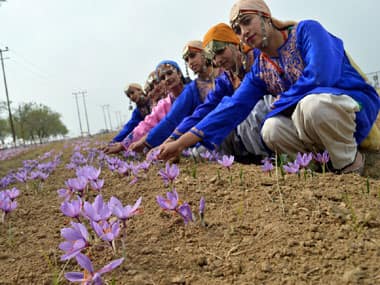Farooq Ahmad Ganaie, a 39-year-old resident of Pampore town in south Kashmir, owns ten hectares of land on which he cultivates saffron. A few years ago, this land was his only major source of income, fetching him lakhs of rupees each year. But for three years now, yield from his farm has fallen dramatically, matched by the dip in revenue. “It was a flourishing business once. It fetched us millions of rupees. But now we are only losing money as well as faith in the institutions of the state. We want sell our land,” Ganaie told Firstpost. [caption id=“attachment_1231813” align=“alignleft” width=“380”]  Kashmiri girls during the first harvest of the crop during Saffron festival in Pampore. Shahid Tantray/ Firstpost[/caption] Saffron farmers, strangely, blame the ambitious scheme National Saffron Mission (NSM) for the declining production of saffron. “It’s the scientific methods forced upon us that have destroyed the crop instead of increasing saffron production. And corrupt officials and the lethargic state government are to be held responsible for this,” Ganaie said. The Rs 372.18-crore National Saffron Mission scheme was launched by the Government of India in partnership with the state government in 2010. The cost was to be shared by the state and central governments. The four-year scheme was aimed at the economic revival of Jammu and Kashmir’s saffron sector, its aim being o raise the production to 5 kg per hectare from 3 kg. Strangely enough, farmers now blame the same mission for declining production. The Central government had introduced initiatives to provide irrigation. These are yet to come, and although the money has been sanctioned and allotted by the Central government, it is yet to be released by the state government. Most farmers say that until they pay bribes to officials, borewells and other material, which was to have been provided by the government for a more scientific way of growing saffron, are simply not made available to them. The culprit is the new farming techniques, requiring more irrigation. “The government first motivated us to introduce new techniques in cultivation of saffron that need irrigation on a regular basis. A grower was to get Rs 25,300 per kanal of land for construction of bore wells in their saffron fields. The money never came and the production went down. We were better with out traditional ways of cultivation,” Abdul Majid Wani, General Secretary, Saffron Growers Association said. The traditional ways of growing saffron, Wani says, were much easier and production would unfailingly increase every year. Kashmir is an important producer of saffron globally. In fact, apart from Iran and Spain, Pampore has the largest saffron cultivations anywhere in the world. It is the most expensive and precious spice in the world. The saffron filaments or threads are actually the dried stigmas of the saffron flower. Each flower contains three stigmas. These threads must be picked from flower by hand, and more than 75,000 of these flowers are needed to produce just one pound of Saffron. The rich spice was brought to India by Persian rulers, around 500 BC. To save the heritage crop, the government of Jammu and Kashmir banned any construction near land were this crop is grown in Pampore, but illegal constructions have crept into much of the land over the last 20 years. Saffron covered 5,400 hectares of land in Kashmir in 1997, it’s now reduced to 3,000 hectares. The production per hectare has also fallen from 3.1 kg per hectare to 1.3 kg per hectare over the last three years, say farmers, forcing many of them to sell the land. Pointing towards newly built houses on fields near Pampore, Altaf Ahmad Saraf, a farmer, says this is the result of l,and mafia and corrupt government officials who have given permission to people to build houses illegally. “But people don’t want to grow saffron any more because cheap and adulterated saffron available from Iran has given Kashmiri saffron tough competition. Kashmiri saffron remains expensive as the output is less,” Saraf told Firstpost. Come October, land in Pampore is dotted with purple saffron flowers, neatly lined columns and rows of them, just 13 kilometers from the summer capital of Srinagar. Last year Ganie’s land yielded 200 grams of saffron but this year the output has been not even 50 grams. “I didn’t earn even Rs 50,000 this year. I used to earn more than Rs 10 lakh from this land a year.” Under the National Saffron Mission 1500 hectares of land were to be taken up and borewells constructed for better irrigation. The failure of the scheme for the past two years has forced saffron growers not to pursue the cultivation of saffron this year. The Mission was launched in 2011 to boost saffron production in the state. But due to corruption and mismanagement by the government, farmers have lost what they had before the scheme was even launched. “The failure of state government to facilitate construction of borewells in saffron fields has spelt doom for the saffron growers. This has led to a negative publicity of NSM and the saffron growers have decided to adopt the traditional methods of cultivation of saffron,” said Maozam Qadri, a resident of Pampore town and a saffron farmer. People associated with saffron farming say if the present state continues then the day is not far when Kashmir will lose its heritage crop.
The culprit is the new farming techniques, requiring more irrigation, not backed up provision of funds for construction of borewells. Production has been declining drastically.
Advertisement
End of Article


)

)
)
)
)
)
)
)
)



